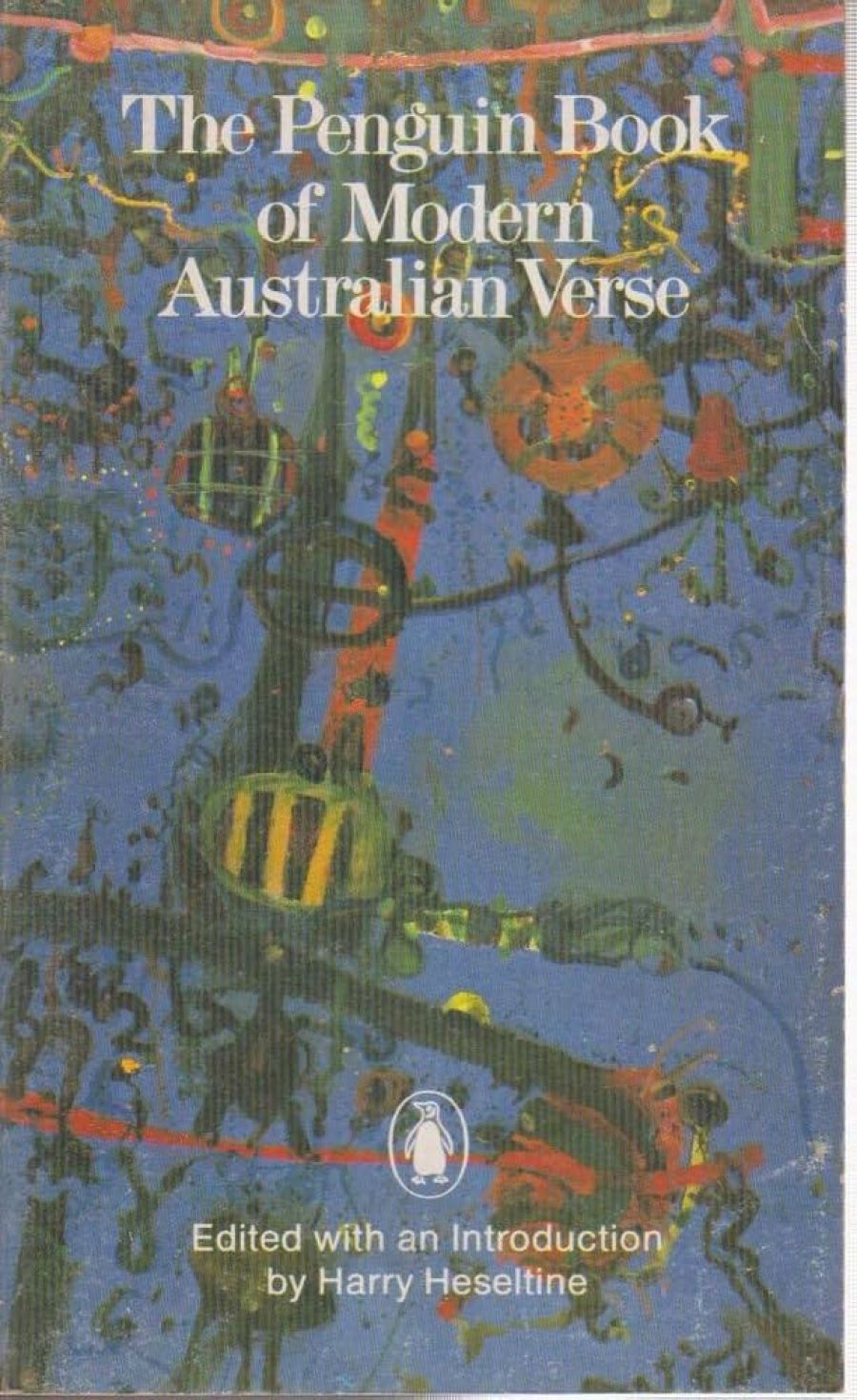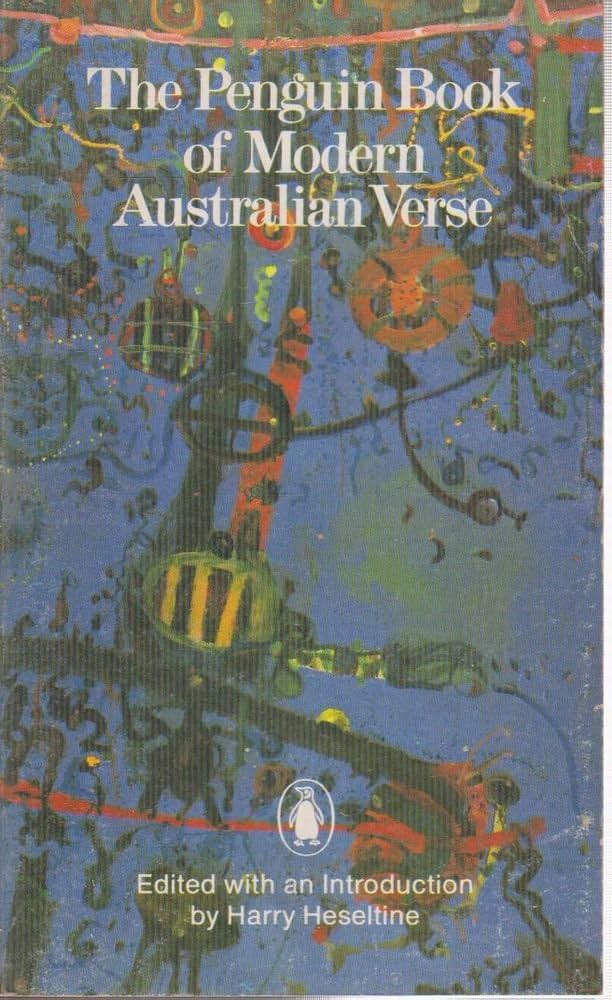
- Free Article: No
- Contents Category: Poetry
- Review Article: Yes
- Article Title: New Horizons Please
- Online Only: No
- Custom Highlight Text:
The appearance of anthologies which have the intention of representing the poetic output of a specific ‘era’ often indicates that era's having achieved a status of authority. Harry Heseltine’s Penguin Book of Modern Australian Verse anthologizes poetry of the nineteen-sixties and seventies, and just as surely as in any such anthology, the poetry of these decades becomes relegated to the past tense.
- Book 1 Title: The Penguin Book of Modern Australian Verse
- Book 1 Biblio: Penguin, $4.95 pb, 214 pp
- Book 1 Cover Small (400 x 600):

- Book 1 Cover (800 x 1200):

In this selection, Heseltine has rigorously excluded those modern Australian poets whose work gained recognition before the early nineteen-fifties. While acknowledging the continued contribution made by poets like A.D. Hope and Judith Wright during the sixties and seventies, the editor has chosen to attempt a more thorough coverage of the poets born in the nineteen-forties (who became the ‘generation of ’68’), and of the earlier generations of poets who emerged during the ‘transitional’ years of the nineteen- sixties.
This anthology offers afresh the opportunity for us to make uncluttered observations of the Australian poetry of the sixties and seventies, largely thanks to the editor's effort in avoiding ‘political’ bias. The disjunctive syntax, and the dissolution of traditional logical grammatical and rhythmic structure characterize these poems as belonging recognizably to the last two decades. The stringing together of words and agglomeration of phrases are methods of poetic construction which have become, for most of the poets of this anthology, the ideal mode through which their thoughts can be given expression.
In ‘Lear, Class ’71’, for instance. Fay Zwicky observes the gulf between a generation which has become formalized in its ways of thinking, and the younger generation which is on its way to accepting and learning these. The shame lies in the way in which realities of literature, and of life, are lost to both generations. The poem uses short lines, brief mocking quotations and cliches, and a dishevelled representation of action and thought, to achieve its broken, angular effect.
Such features can be observed, to varying extents, in the poems of Bruce Dawe, Rae Desmond Jones, and Richard Tipping, to name just an arbitrary few. Martin Johnston’s ‘Gradus ad Parnassum’ uses cliches and broken lines of thought (in a more verbose context), to recreate the spontaneous disorder of the mind’s thinking and reasoning. Similarly, effects of language and novelties of structure are used to present the randomness and unrelatedness of childhood reminiscences, as in Robert Gray’s recollections of a country childhood, and in the urban perspective of Peter Skrzynecki’s ‘10 Mary Street’.
From our view, in 1981, many instances of these techniques have taken on the peculiar characteristic of datedness. Undoubtedly, this stems from the sense of ‘historical urgency’ which Heseltine observes. There was a feeling that poetry ‘must be made, or appear to be made, on the instant because tomorrow or the day after may be too late’. Heseltine’s anthology presents a thoughtfully selected cross-section of recent poetic efforts, giving us the opportunity to decide for ourselves to what extent poems and poets have been able to find a means of transcending the passage of time.
This urgency is also present in the poems of this anthology where the writer has been intent upon expanding poetry’s use of language in new expressive ways. In some cases, one senses, this experimentalism has progressed more rapidly than the poet’s capacity for new thoughts and original ideas. In other words, formal experimentalism threatens to outstrip the very need for those new forms, and begins to dictate over content. The use of technical effects which have little relevance to the poem’s meaning become mere irritations, as with Russell Deeble’s typographical effects in ‘The Gnome’.
The effect of the sense of urgency upon poetic output can be observed throughout the anthology. Vicki Viidikas dispenses with the obscurity of some of her fellow poets to openly proclaim her desire to dismiss structural considerations, and aim for ‘The Whole Bag’ of truthfulness to reality as well as poetic fidelity, while Robert Adamson hints at a realization that, too easily, ‘slogans and banter pour forth’ in the poetry of his decade. The poets of this anthology who have been able to make use of new forms of poetic expression, while retaining some fidelity to poetic expressiveness (dare I say, inspiration?), are few in number. David Malouf provides perhaps one example, with his classical perspective, and feeling for subtle effect.
For the rest, how much do we feel that a dedication to the poetic forms their generation has developed has become the prime theme? Characterized by a self- conscious linguistic formalism, such poems rarely go beyond the secure world of thought of their own ‘intellectual- literary’ circles. Having become adept at these experimental forms and techniques, these poets need now to look for new areas of exploration, where experimentalism in language and novelties of structure can no longer provide a poem’s justification.


Comments powered by CComment